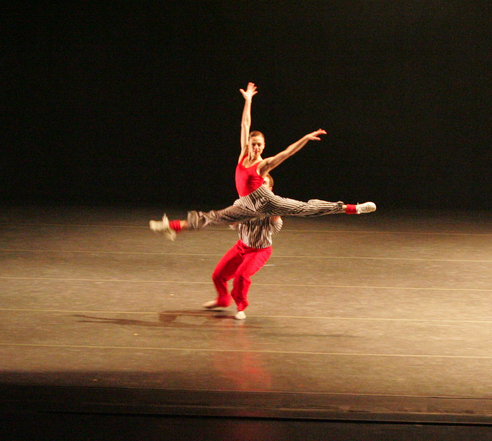It’s worth the trip, believe me. Founded and directed by former New York City Ballet star Edward Villella, the troupe’s fluency–its capacity to energize the whole stage–is an essential quality of Balanchine, their mainstay, that sometimes gets tamped down. MCB will be performing three of his works at Tilles Center on Long Island.
It’ll also be interesting to see what they do with Tharp’s “In the Upper Room,” which I, at least, have only seen American Ballet Theatre do.
Here’s my Newsday profile on one of their loveliest ballerinas, Jennifer Kronenberg, plus Villella talking about the Long Island program. (Imagine a sidebar.)
in Twyla Tharp’s “In The Upper Room.” Photo by Joe
Gato.
April 20, 2008
“Arrive to go,” the onetime New York City Ballet star Edward Villella likes to tell members of his swift and supple Miami City Ballet, which spins into Tilles Center next weekend. “Move!” he often exclaims during class and rehearsal.
Queens native Jennifer Kronenberg has never needed to be told. As a tot, the Miami City Ballet principal says, she “jumped around like a crazy girl” whenever ballet was on TV. Her grandmother suggested ballet class once a week. “No, no, no — every day,” responded Kronenberg. She soon got her wish.
Besides beauty, wit and an unforced musicality, Kronenberg has “a marvelously sympathetic quality onstage — your heart just goes out to her,” Villella says. And she’s got range. “The wonder of Jennifer is she can do anything from ‘Giselle’ to Balanchine. Her ease of movement lends itself to so many areas, and that I don’t see very often.”
Kronenberg learned early that “part of being a good dancer is being a chameleon — changing physically, theatrically and psychologically with each role,” she says. She remembers Teresa Aubel, director of the performing arts academy Once Upon a Time in Richmond Hill, where she received the bulk of her early training, telling her, “You must do what the teacher wants. Everyone has something individual to teach.”
Barbara Walzack — with the New York City Ballet during its founding years — instilled in Kronenberg the speed, placement of the body and musical sensitivity that she would need for Balanchine’s School of American Ballet, where Villella discovered her. (“Miami City Ballet called,” the school told her a few days after his visit. “They want to know your shoe size.”) From the late Nicholas Orloff, once in various Ballets Russes, she learned “to feel free,” she says. His classes always ended with flying leaps.
And since 1994, when she joined the Miami troupe as an apprentice, she has proved equally receptive to the individual lessons of its large repertory. She’s been wittily urbane in Balanchine’s “Rubies” (what she calls her “super exciting, super nerve-racking” first big role); mesmerizing and mysterious in his “La Somnambula”; and in his “Ballet Imperial,” a woman so lovely in her majesty that her lover will probably never recover from her saying goodbye.
At Tilles, she confronts a whole other beast: “In the Upper Room” by Twyla Tharp, of “Movin’ Out” fame. It completes a program of Balanchine works that includes “Raymonda Variations,” “Sonatine” and “Tarantella.”
“It’s calisthenic exercises–karate, boxing, jogging, all kinds of things from the gym– turned into pure jazz,” Villella says. “The ‘upper room’ is where the mind goes when the body is fully physical.”
One of only two dancers onstage at start and finish, Kronenberg embodies “the epitome of physical well-being,” she says. “This dancer is strong and confident and getting her kicks out of driving harder and harder.” Perhaps like Tharp herself. After working with the choreographer on the world premiere last month of “Night Spot,” to an original Elvis Costello score, Kronenberg can attest that “she’s intense. At the end of every rehearsal, she would say, ‘Excellent. Tomorrow, do more.’ She brought things out of dancers I’d never seen before.”
As for the 40-minute “In the Upper Room,” from 1986, “It was such a triumph the first time we made it through,” says Kronenberg. It took weeks to build up to that point. “I never imagined I could feel that exhausted.”
Villella has four of a kind
Edward Villella talks about the works that Miami City Ballet will perform at Tilles Center:
“Raymonda Variations.” Balanchine embellished the 19th-century grand Russian manner, which he understood perfectly, with 20th-century speed and sophistication. He was responding less to the “Raymonda” story [about a vivacious young woman in need of a husband] than to its flavor.
“Sonatine.” It’s like a very fine piece of Limoges china. It’s about the gentle regard between man and woman in French Romanticism. It’s an homage to Woman, which of course was the Balanchine credo.
“Tarantella,” made on Villella in 1964. When I joined the New York City Ballet and got to do “Prodigal Son,” a critic asked, “Why are you giving a kid like that a role like this?” Balanchine said [Russian accent], “Because, you know, he looks like nice, little Jewish boy.” I expect for “Tarantella” he thought “nice little Italian boy”!
“In the Upper Room.” A good piece to end with, as there’s not much you can do after it except beg for a cold beer!
WHEN&WHERE Miami City Ballet performs Friday and Saturday at Tilles Center on the C.W. Post Campus of Long Island University, Route 25A, Brookville. On Friday, Edward Villella will give a pre-performance talk at 7 p.m. $5 with tickets. Tickets $40 to $75. Call 516-299-3100 or visit tillescenter.org.
Copyright © 2008, Newsday Inc.


Leave a Reply